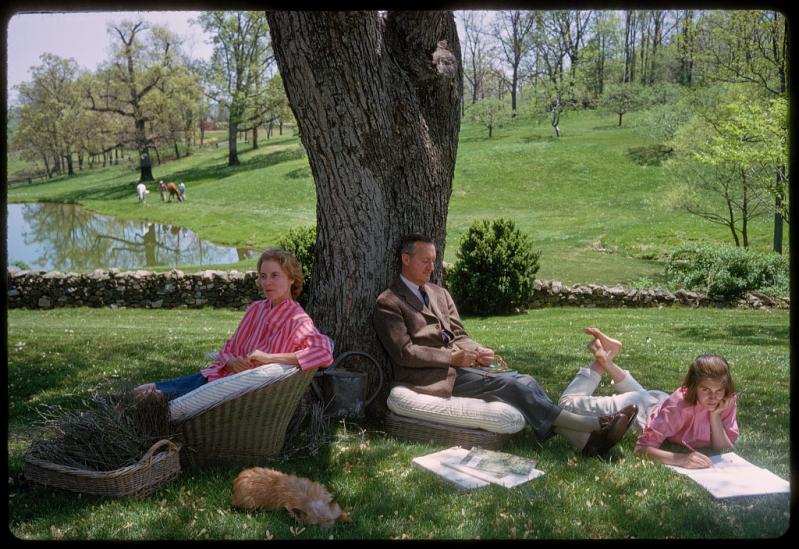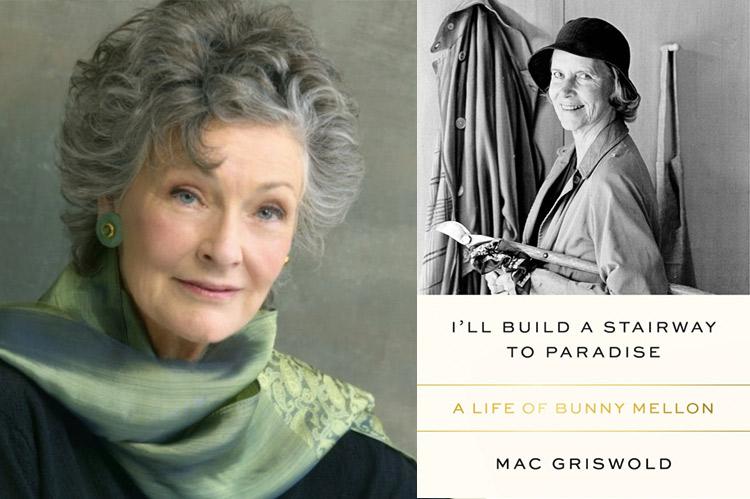“I'll Build a Stairway to Paradise”
Mac Griswold
Farrar, Straus and Giroux, $40
Rachel Lambert Mellon, known to everyone as Bunny, was a self-taught master of landscape design, a discerning art and rare-book collector, and an icon of style and grace. She grew up in wealth, then inherited wealth, and went on to marry one of the richest men in the world, Paul Mellon.
Driven and possessed of an endless curiosity, by the time Bunny Mellon died in 2014 at the age of 103, the Listerine heiress had been lauded for landscape and garden designs that included the White House Rose Garden and East Garden, John F. Kennedy's gravesite at Arlington National Cemetery, and the JFK Library and Museum grounds overlooking Boston's Dorchester Bay. She designed Hubert de Givenchy's gardens in Paris and at his nearby chateau, Le Manoir du Jonchet, later assisting in the restoration of the Potager du Roi at Versailles. She also designed numerous private gardens and interiors while presiding over her own homes in New York, Paris, Cape Cod, Nantucket, Antigua, and Virginia.
While her elegance and refinement were admired across continents, Mellon was a deeply private person, averse to the spotlight, making the achievement of Mac Griswold's exquisite biography, "I'll Build a Stairway to Paradise: A Life of Bunny Mellon," all the more remarkable in its breadth and veracity. Buoyed by her conversations with Bunny Mellon, whom Ms. Griswold knew personally, that spanned a two-year period in the 1990s, the author endeavored to find the true character of this complex woman. Poring over Mellon's personal journals, private archives, correspondence, and garden records, she also spoke with innumerable friends and colleagues, fellow gardeners, family members, and staff. What emerged is the story of a courageous and brilliant visionary whose life, in spite of immense privilege, would not escape adversity or cataclysmic loss.
In childhood, Mellon was catered to by servants and nannies who, it seems, managed her parenting as well. It would be her maternal grandfather, Arthur Houghton Lowe, with whom she often hiked New Hampshire's mountainsides on early mornings, who opened her eyes to the magic of the natural world. Ms. Griswold quotes from Mellon's notes, "But it was the sky, that great space — ice blue, lazy blue, dark blue, full of stars — angry or hidden by fog — what a little world we are, looking at that sky. Space, and how to use it, for me, is the beginning of every garden."
Mellon's first marriage, to Stacy Barcroft Lloyd Jr., produced two children. But, upended by war and infidelity, in 1948 the couple divorced. Sparing no time, she and Paul Mellon, a widower, married after a trip abroad, merging their families and their massive fortunes. Their life was one of extravagance and philanthropy, with lavish parties in multiple homes that transported her blue-blood chums to an otherworldly grandeur.

Toni Frissell Collection, Library of Congress Prints and Photographs Division
Among their circle of friends were Jacqueline and John F. Kennedy, I.M. Pei, the actor Frank Langella, Bette Midler, and, on occasion, Queen Elizabeth II and Prince Philip. She and Jackie would become the closest of friends, and even America's tastemaker, the first lady, deferred to Bunny for style notes. Ms. Griswold writes, "Bunny, nineteen years older than Jackie, could take on the role of teacher and exemplar at one moment and then shift to become the cozy, sympathetic friend to whom Jackie poured her heart out."
When President Kennedy asked her to redesign the White House Rose Garden, the author notes, "In asking Bunny Mellon to create this setting, he had hired the perfect impresario to create the mise en scene for a new political discourse."
Her formal restraint in design (she famously described her style by saying "nothing should be noticed") didn't, apparently, translate to her taste in jewelry. On spending sprees at Tiffany's, she was adorned by Jean Schlumberger, the celebrated jeweler, whom she met in 1954. In alliance with Cristobal Balenciaga and Givenchy, he took it upon himself to recreate her as a fashion icon. And so she became. Today, her wardrobe alone would run about $3 million a year.
Still, Bunny Mellon didn't mind getting her hands dirty. She could often be found with a trowel in one hand and clippers in the other as she pruned back the shrubs at the family's sprawling estate, Oak Spring Farm in Upperville, Va.
With her impeccable eye, Bunny also fortified the couple's staggering art collection with Impressionist and post-Impressionist artworks, then moved on to modernism with major acquisitions of works by Mark Rothko, Richard Diebenkorn, and Georgia O'Keeffe. Her avid collecting, however, was no match for the extraordinary philanthropy the couple undertook. They donated more than a thousand works of art to the National Gallery of Art, founded by Paul Mellon's father in 1937, including paintings by Monet, Cezanne, Renoir, Van Gogh, Manet, Winslow Homer, and Picasso. Their tremendous support of the arts and humanities continues through the Andrew W. Mellon Foundation, established in 1969.
When, after five years, their marriage began to sour, they remained married, notwithstanding Paul Mellon's long-term affair with Dorcas Hardin, whom Bunny claimed to have "found" for him. Time apart — he in D.C., she in Paris — seemed mostly agreeable. "For fifty-one years they would pay attention to one another with a constant stream of letters, notes, and gifts, especially from him to her," Ms. Griswold writes. "Paul Mellon's light verse would make him the Ogden Nash of millionaires. The beautiful surroundings Bunny created made their life appear seamless from decade to decade. Their struggle to stay together would be remarkable — touching. They had grasped that living apart would keep them together." For Bunny's part, she embarked on a series of infatuations with world-famous designers, mostly gay men, who dressed, designed, and coiffed the elite.
In 2000, a year after her husband died, Bunny's beloved daughter, Eliza, was hit by a truck while crossing the street in Lower Manhattan. She would live her remaining eight years as a quadriplegic, unable to speak. "Like a bird smashing itself against a windowpane to get out, Bunny tried every means to get Eliza to communicate with her. 'If she could just speak,' Bunny would often remark, 'say just a few words, tell us what she wants.' "
She spent much of her convalescence at Oak Spring Farm, now the site of the Oak Spring Garden Foundation. Among its many features, the estate houses a garden library containing over 18,000 rare books and objects related to horticulture, garden design, and botany. Bunny Mellon's garden designs there remain virtually unchanged.
Ms. Griswold's sweeping portrait of Bunny Mellon, while sympathetic, doesn't spare her subject's less tasteful traits. She could be imperious and acerbic, sometimes unapologetically cutting off longtime friends without cause. In spite of a privileged upbringing, her high school education hardly prepared her for a life among the cultural elite. Social climbing, however, seemed to come naturally if not always easily.
In her time, she endured a few scandals, too. Her financial support of the then-presidential hopeful John Edwards, a senator from North Carolina, would land her in hot water once his campaign dissolved into federal indictments. But she remained ascendent, her confidence undeterred by the front pages of frenzied tabloids.
Through Mac Griswold's meticulous research and spirited writing, we enter the haut monde as it existed through most of the 20th century, including its politics, its excesses, and, most of all, its elegance, much of which was designed by Bunny Mellon, a self-taught horticulturist and creator of dreams.
Janet Goleas is an artist, curator, and writer who lived in East Hampton for many years before recently moving to Florida.
Mac Griswold, formerly of Sag Harbor, is the author of "The Manor," a history of Shelter Island's Sylvester Manor.

